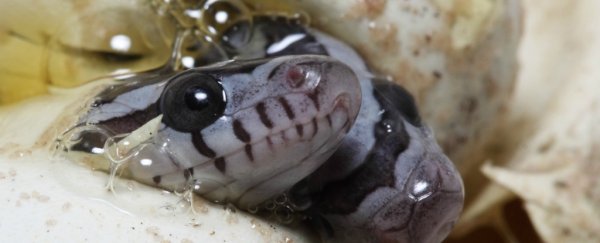This article was written by Jenny Graves from La Trobe University, and was originally published by The Conversation.
Christmas seems an appropriate time to ask whether it's biologically possible to have a virgin birth. And you may be surprised to hear that it is possible – just not for humans, or any other mammals. Experiments with mice and other mammals show an egg must be fertilised with a sperm to kick off development of any kind. Just stimulating a mammal egg with chemicals or electricity doesn't trigger it to divide normally.
It seems you need particular proteins from sperm to set up waves of calcium ions in the egg, which trigger further changes leading up to copying all the DNA and chromosomes, and dividing into two cells.
But you need more than just a protein trigger supplied by the sperm. You also need two copies of each chromosome in the fertilised egg. Normally one set is provided by the mother (in the egg nucleus) and one by the father (in the sperm nucleus).
You can engineer a mouse egg to have both nuclei from the same sex, but this doesn't work. An egg with two maternal nuclei goes some of the way to making an embryo, but it shrivels up because there is little development of placenta. If both nuclei come from a male there is the opposite problem: a lot of placenta but hardly any embryonic development.
But why not?
It turns out that there are more than 30 imprinted genes that are active only if they come from a father through sperm. There are another 30 plus that are active only if they come from the mother. So genomic imprinting prevents virgin birth in all mammals, including humans.
Genomic imprinting is the different activity of genes according to which parent they come from. It was discovered in the 1990s, with its mechanism only sorted out in the last decade. It seems that the inactive gene is not mutated, but is silenced by attaching chemical groups to the DNA. These chemical groups are put onto genes in the testis or the ovary, and are removed during growth of the embryo.
Evidence that this silencing messes up uniparental embryos comes from engineering mice in which the imprinting process on one key gene is disrupted, leading to viable embryos with two mothers.
But it's still a mystery as to why imprinting evolved. Was it selected for because it prevented virgin birth? Or was it the result of a war between the mother's and father's genes? This 'sexual antagonism' is suggested by the functions of many of the imprinted genes.
Generally, active genes from the father directly or indirectly promote growth, whereas active genes from the mother suppress growth. It has been suggested that the father's genetic interests are best served by producing the biggest, toughest baby, whatever the cost to the mother (you can always find another female to mate with). The mother's genetic interests are best served by limiting the claims on her health and energy so she can survive to bear more children.
Virgin birth in other animals
But virgin birth is possible, if you're a reptile or a fish. For instance, pythons and Komodo dragon females that were long isolated were found to produce young that had only genes from the mother. It now seems to be an option in some snake species, and is known in several species of shark. Handy when there are no males around!
In fact, there are several lizards that are exclusively female. Some whiptail and gecko species in the arid southwest of the USA and the hot and dry interior of Australia have females whose unfertilised eggs develop fully – all into daughters.
The process is called parthenogenesis (literally 'virgin creation'). The animals that practise it (snakes, sharks and lizards) don't have to worry about genomic imprinting, which does not occur in egg-laying animals.
There are several ways reptiles can accomplish this. A female can make fertile eggs with the right number of chromosomes either by fusing an egg cell with another cell with one set of chromosomes. Alternatively the egg progenitor can undergo a variant form of division that leaves two copies of the genome.
This isn't exactly cloning, because the mother's gene copies are scrambled, but it does mean that all the genes of the offspring come from the mother.
Why sex?
The occurrence of parthenogenesis in reptiles poses a puzzle: what is the point of sex anyway? Wouldn't your genes do better in the evolutionary race if your offspring received genes only from you? This 'twofold cost of sex' has been a serious question in the field for 80 years.
The answer seems to be that although parthenogenesis works fine in the short term, it will always lose out in the long run because recombining two genes each generation is a great way of scrambling the combinations of proteins that pathogens see.
A pathogen that can infect one individual can also infect others with the same genes, so it's no point in having many cloned copies. For instance, the female-only Australian gecko is very susceptible to mite infestation.
So the answer to the question of whether virgin birth is a real possibility is: yes, unless you are a mammal.![]()
Jenny Graves, Distinguished Professor of Genetics, La Trobe University
This article was originally published by The Conversation. Read the original article.
